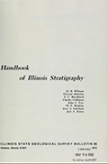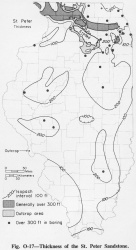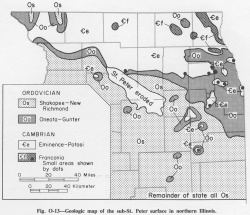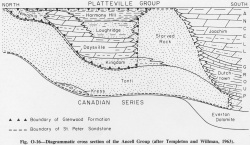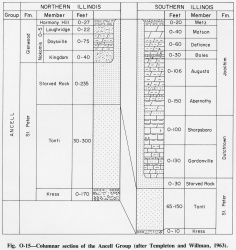Historical:St. Peter Sandstone: Difference between revisions
mNo edit summary |
(No difference)
|
Latest revision as of 16:01, 21 December 2016
Lithostratigraphy: Ottawa Limestone Megagroup >>Ancell Group >>St. Peter Sandstone
Chronostratigraphy: Paleozoic Erathem >>Ordovician System >>Champlainian Series >>Blackriveran Stage
Allostratigraphy: Tippecanoe Sequence
Authors
H. B. Willman and T. C. Buschbach
Name Origin
The St. Peter Sandstone (Owen, 1847, p. 169-170; Calvin, 1906, p. 73; Bevan, 1926, p. 6) is named for the St. Peter River in Minnesota, now called the Minnesota River.
Type Section
The type section of the St. Peter Sandstone is in the river bluffs at Fort Snelling on the southeast edge of Minneapolis.
Correlation
The St. Peter Sandstone is equivalent to a sandy zone at the base of the Pamelia Formation in New York and to a light-colored dolomite at the base of the Murfreesboro Limestone in Tennessee.
Extent and Thickness
The St. Peter Sandstone is present in most of Illinois (fig. O-17). The St. Peter is well exposed along the Illinois and Fox Rivers near Ottawa (fig. O-2A), the Rock River near Oregon, and the Mississippi River near West Point Landing in Calhoun County. The St. Peter Sandstone varies from only a few feet to more than 700 feet thick, but commonly it is 100-200 feet thick. The greater thicknesses occur in northern Illinois, where the pre-St. Peter surface had sharp relief on a strongly developed karst topography and a north-facing escarpment of early Ordovician and late Cambrian dolomite formations (Buschbach, 1961).
Stratigraphic Position
Because of a major unconformity at its base, the St. Peter truncates formations as old as the Cambrian Franconia Formation (fig. O-13). It is generally overlain by the Glenwood Formation in northern Illinois, the Joachim Dolomite in the central part of the state, and the Dutchtown Limestone in the extreme south, and it has a facies relation to these formations (fig. O-16).
Description
The St. Peter consists largely of fine to medium, well sorted, well rounded, frosted grains of quartz sand that is friable or weakly cemented. Except in a few local areas, the St. Peter is exceptionally pure quartz sand, essentially free from clay, carbonates, and heavy minerals. Some beds have low-angle cross bedding, but the bedding is largely horizontal (Lamar, 1928a; Willman and Payne, 1942; Buschbach, 1964). The St. Peter includes three members, the Kress Member at the base (chert, sand, clay, and shale), the Tonti Sandstone Member, and the Starved Rock Sandstone Member (fig. O-15). The St. Peter Sandstone is extensively quarried for silica sand and is one of the major aquifers in Illinois.
Fossils
The St. Peter is nonfossiliferous, except for local worm borings (Scolithus) and a few scolecodonts in the upper part of the formation.
Depositional Environment
The St. Peter is generally considered to be a marine sand deposited near the shore of a sea advancing from the south (Dapples, 1955).
References
BEVAN, A. C., 1926, Glenwood beds as a horizon marker at the base of the Platteville Formation: Illinois State Geological Survey Report of Investigations 9, 13 p.
BUSCHBACH, T. C., 1961, Morphology of the sub-St. Peter surface of northeastern Illinois: Illinois Academy of Science Transactions, v. 54, p. 83-89; Illinois State Geological Survey Reprint 1961-Y.
BUSCHBACH, T. C., 1964, Cambrian and Ordovician strata of northeastern Illinois: Illinois State Geological Survey Report of Investigations 218, 90 p.
CALVIN, SAMUEL, 1906, Geology of Winneshiek County: Iowa Geological Survey, v. 16, p. 37-146.
DAPPLES, E. C., 1955, General lithofacies relationship of St. Peter Sandstone and Simpson Group: American Association of Petroleum Geologists Bulletin, v. 39, p. 444-467.
LAMAR, J. E., 1928a, Geology and economic resources of the St. Peter Sandstone of Illinois: Illinois State Geological Survey Bulletin 53, 175 p.
OWEN, D. D., 1847, Preliminary report of the geological survey of Wisconsin and Iowa: U.S. General Land Office Report, 1847, p. 160-173.
WILLMAN, H. B., and J. N. PAYNE, 1942, Geology and mineral resources of the Marseilles, Ottawa, and Streator Quadrangles: Illinois State Geological Survey Bulletin 66, 388 p.
ISGS Codes
| Stratigraphic Code | Geo Unit Designation |
|---|---|
